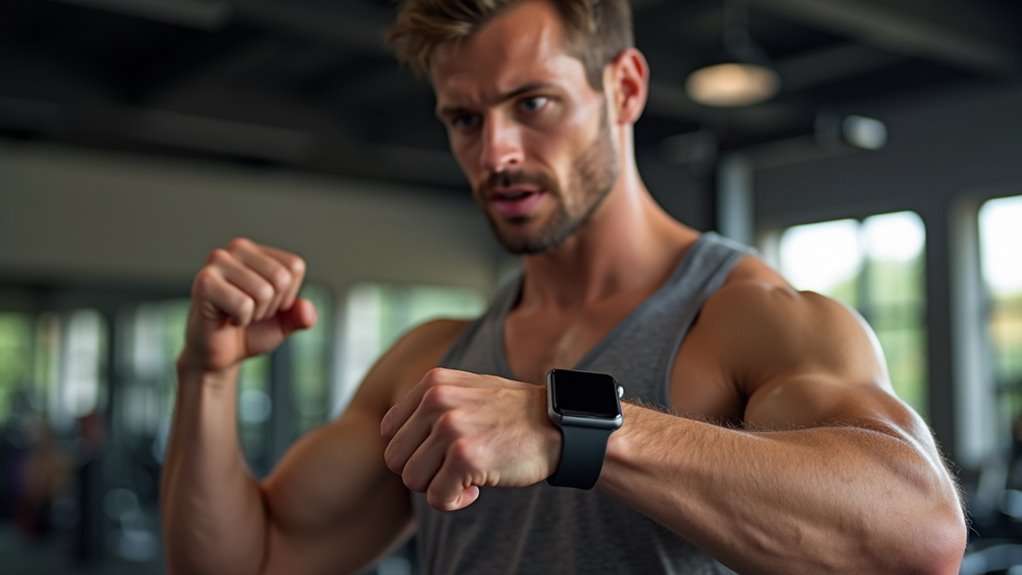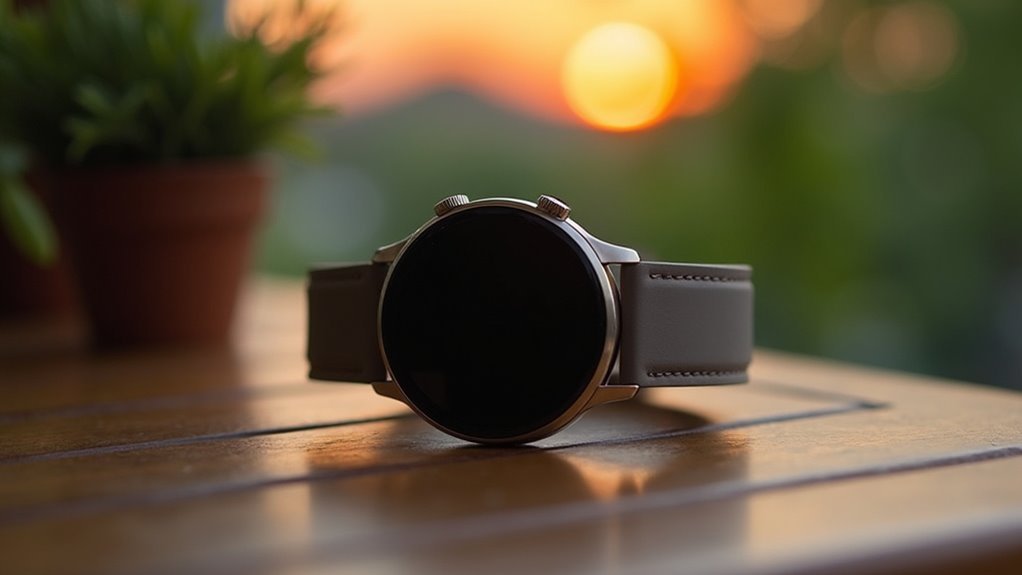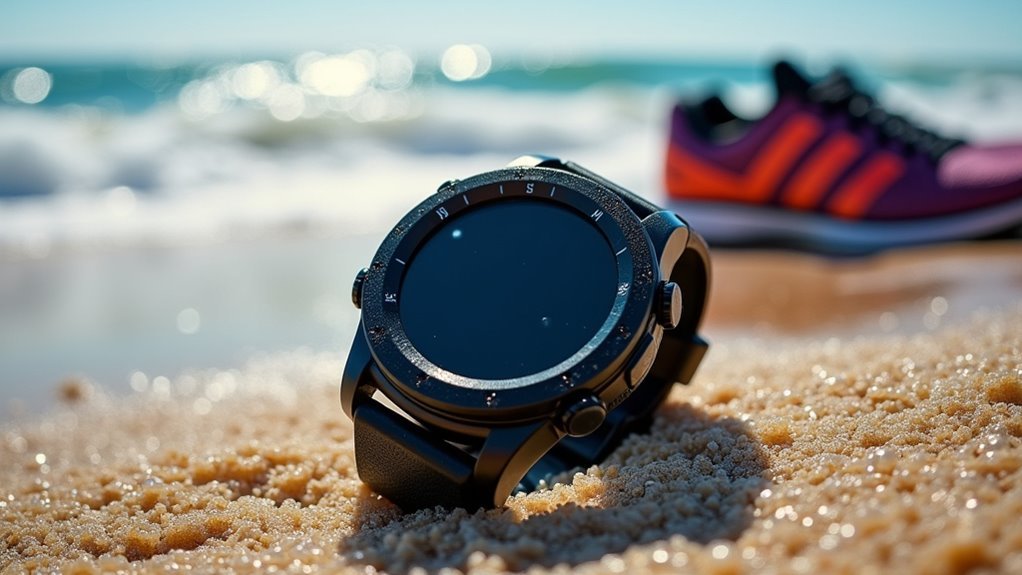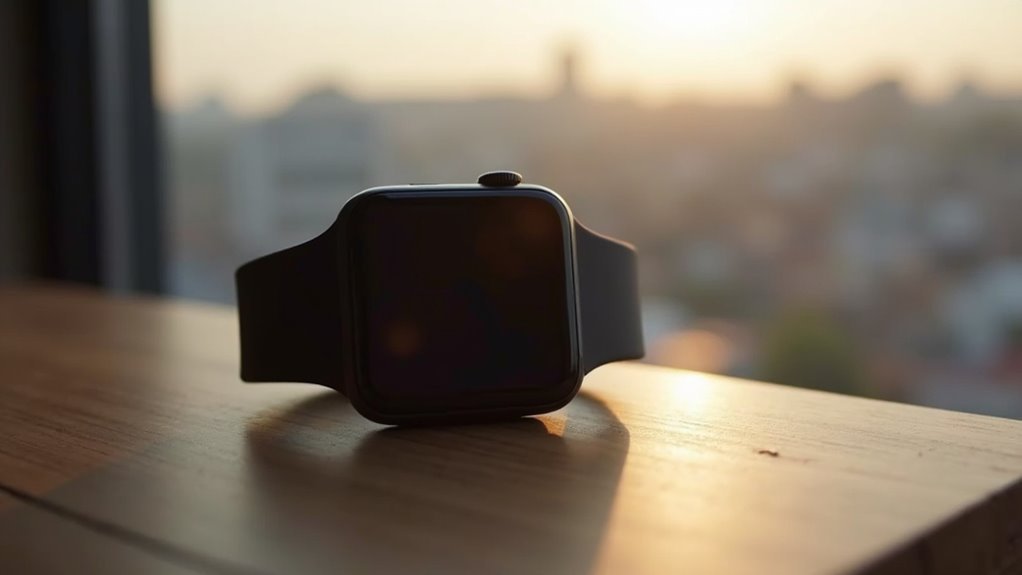You can control your workout music hands-free using voice commands through smartphone assistants like Siri or Google Assistant, keeping your focus on proper form and training intensity. Smart devices like fitness watches serve as central hubs for playlist management, while sweat-resistant headphones with voice activation guarantee reliable performance during intense sessions. Voice commands allow instant tempo adjustments that sync with your heart rate and workout phases. Discover advanced integration techniques that’ll revolutionize your training sessions.
Voice Commands That Keep You Moving

How often do you find yourself fumbling with your phone mid-workout, breaking your rhythm just to skip a song or adjust the volume?
Voice commands eliminate these workout-disrupting moments by keeping your hands free and your focus sharp. You can instantly switch to your preferred music, maintaining that essential motivation boost that keeps you pushing harder.
Voice commands keep your hands free and focus laser-sharp, delivering instant music control that powers your workout momentum.
Research shows music enhances endurance by up to 15%, but only when it matches your energy level. Voice commands utilize artificial intelligence to better understand your music preferences and workout patterns.
Voice assistants learn your listening habits, delivering personalized recommendations that sync with your workout intensity.
Whether you need to jump to an energizing track during strength training or dial down the tempo for cool-down stretches, simple voice commands maintain your workout flow without missing a beat.
Hands-Free Music Control During Cardio Sessions
You can’t afford to break your stride during cardio just to skip a song or adjust volume.
That’s where voice commands transform your workout experience, letting you control music while your hands stay focused on form and movement.
Whether you’re dealing with sweaty fingers or need instant playlist changes mid-run, voice control keeps your music perfectly synced to your session’s intensity. Research shows that faster music tempo correlates with higher power output, making instant tempo adjustments through voice commands crucial for optimizing your performance.
Voice Commands While Running
When you’re pounding the pavement or grinding through an intense cardio session, fumbling with your phone to change tracks can derail your rhythm and compromise your safety. Voice commands solve this problem by keeping your hands free and your focus sharp. You can simply say “Play music for working out” or “Turn it up” to adjust your audio without breaking stride.
Voice control enables seamless interval training management through timer commands and provides real-time workout feedback alongside your music. You’ll stay motivated by easily switching playlists based on your intensity or mood. Many fitness apps offer customized audio cue settings that allow you to personalize the frequency and type of verbal updates you receive during your workout.
However, outdoor running presents challenges—wind and traffic noise can interfere with recognition accuracy, and command responsiveness varies across platforms like Spotify and Pandora.
Sweat-Proof Audio Controls
While voice commands provide excellent hands-free control, intense cardio sessions demand equipment that can withstand the punishment of sweat, moisture, and constant movement.
You’ll need waterproof and sweat-resistant headsets with IP67 ratings that guarantee dust and water protection during high-intensity workouts. Look for devices featuring anti-corrosion treatment and rubber-coated materials that prevent moisture damage.
Wireless connectivity eliminates cable interference, while noise-canceling technology maintains audio clarity in noisy gym environments. Professional systems offer 4+ hours of continuous battery life, ensuring your audio commands remain functional throughout extended training sessions.
You’ll appreciate replaceable components like cables that extend your equipment’s lifespan and reduce costly downtime. Products like the H2O7 and HSM24 offer professional-grade durability specifically designed for fitness use.
Sealed switches prevent moisture entry, ensuring your controls remain responsive when you’re pushing your limits during cardio sessions.
Real-Time Playlist Adjustments
How can you maintain peak workout intensity when your current playlist isn’t matching your cardio rhythm? Real-time playlist adjustments solve this challenge by letting you modify music selections instantly through voice commands.
You can request songs by specific BPM ranges—like 130-150 beats per minute—that perfectly align with your exercise pace. Apps like Fit Radio deliver tempo-matched mixes designed for different workout phases, while dynamic updates prevent monotony and boost endurance.
During interval training, you’ll benefit from immediate track changes that shift between high-energy sequences and recovery periods. High-intensity workouts require short bursts of maximum effort that demand perfectly synchronized music transitions. This seamless control maintains your focus on breathing and movement rather than fumbling with devices, ensuring your cardio sessions stay consistent and motivating throughout.
Smart Watch Integration for Seamless Audio Management
You can activate voice commands directly from your smartwatch to control music playback without reaching for your phone during intense workouts.
Your watch becomes a central hub for managing workout playlists, adjusting volume, and switching between tracks using simple voice prompts.
This hands-free audio switching capability lets you seamlessly shift between different music sources while maintaining your exercise rhythm. Premium smartwatch models offer advanced features that enhance voice command responsiveness and audio quality during workouts.
Voice Command Activation
When you raise your wrist and speak a simple command, your smartwatch transforms into a powerful audio control hub that eliminates the need to fumble with your phone during workouts or daily activities. Voice activation lets you seamlessly manage music playbook, adjust volume, and switch tracks without breaking your stride.
| Feature | Benefit |
|---|---|
| Hands-Free Operation | Continue exercising without interruption |
| Multi-Platform Support | Works with iOS and Android devices |
| Real-Time Response | Instant audio control during activities |
| Voice Assistant Integration | Siri and Google Assistant compatibility |
Whether you’re using an Apple Watch Series 9 with Siri or an Android Wear device with Google Assistant, voice commands provide effortless audio management. Popular smartwatches feature voice control functionality for discreet operations during training sessions. You’ll experience enhanced convenience and safety while maintaining focus on your training routine.
Workout Music Control
Music becomes your ultimate workout companion when your smartwatch takes control of audio management during exercise sessions.
You’ll discover seamless integration between voice commands and your device’s music capabilities, allowing effortless control without breaking stride.
Your smartwatch responds to voice prompts for volume adjustments, track skipping, and playlist changes while monitoring your heart rate and GPS location simultaneously.
You can store up to 500 songs directly on devices like the Garmin Forerunner 245 Music or stream from Spotify through your Apple Watch Series 9.
Voice-activated music control eliminates the need to fumble with your phone mid-workout.
You’ll customize playlists matching your training intensity while your smartwatch delivers extensive fitness metrics. Premium subscriptions are typically required for offline syncing capabilities with streaming services like Spotify and Amazon Music.
This hands-free approach maximizes convenience and maintains workout momentum through seamless audio management.
Hands-Free Audio Switching
Beyond basic playback control, smartwatches excel at intelligent audio routing between multiple devices and listening environments.
You’ll experience seamless shifts when your watch automatically routes audio from your smartphone to your Bluetooth earbuds without manual intervention. This audio routing eliminates the need to fumble with multiple devices during intense workouts.
Your smartwatch acts as a central hub, managing connections between your earbuds, phone, and streaming services.
When compatibility issues arise, your smartphone can bridge connections to guarantee uninterrupted playback. Starting music on your phone before engaging watch controls helps establish proper media audio connectivity for optimal performance.
You’ll enjoy effortless audio control through button presses, gesture commands, or voice recognition while maintaining complete freedom of movement.
This multi-device coordination creates a streamlined listening experience that adapts to your training needs automatically.
Vocal Shortcuts for Quick Playlist Changes
Anyone who’s fumbled with their phone while driving or struggled to navigate music apps with wet hands knows the frustration of trying to change playlists mid-activity. Voice shortcuts eliminate this hassle entirely.
With 57% of users employing daily voice commands, you’re joining a massive trend that’s reshaping how we control music. Smart speakers like Amazon Echo and Google Home support immediate playlist modifications through speech.
You can use conversational language rather than rigid syntax—80% of voice searches in 2024 are predicted to be conversational. This natural approach speeds up the process considerably.
Since 75% of voice search results rank in the top three, you’ll find your preferred playlists quickly. The combination of 35% smart speaker ownership and seamless streaming platform integration makes vocal shortcuts increasingly accessible for instant playlist control.
The responsiveness is impressive, with voice search results averaging just 4.6 seconds loading time, making music transitions nearly instant during your workout.
Training-Specific Voice Commands for Different Workouts

When you’re deep into a high-intensity interval training session, fumbling with your phone to skip to the next pumping track breaks your momentum and disrupts your flow.
Voice commands solve this problem by enabling seamless music selection tailored to your specific workout type. You can instantly switch to energizing beats for HIIT, mellow rhythms for yoga, or driving basslines for strength training—all without missing a rep.
Voice commands deliver instant music transitions perfectly matched to your workout intensity—no interruptions, no fumbling, just pure athletic flow.
These training-specific voice commands maintain your focus while ensuring the perfect soundtrack matches your exercise intensity.
You’ll find yourself more engaged when the music automatically adapts to your workout phase, whether you’re pushing through cardio intervals or cooling down with stretches. This hands-free operation allows you to manage your playlist without any physical interaction with your device, preserving your workout rhythm.
Voice control eliminates distractions, keeping you in the zone throughout your entire training session.
Wearable Voice Recognition in Noisy Gym Environments
Voice commands work brilliantly in quiet home gyms, but they face a completely different challenge in commercial fitness centers where treadmills whir, weights clang, and conversations echo throughout cavernous spaces. Your wearable’s voice recognition must cut through this acoustic chaos to understand your music commands accurately.
| Challenge | Solution |
|---|---|
| Background noise interference | Advanced filtering algorithms isolate speech |
| Breathless, muffled commands | User adaptation learns your voice patterns |
| Echo and reverb distortion | On-device processing reduces latency |
| Varying acoustic environments | Noise-robust recognition algorithms |
Modern wearables tackle these issues through specialized chips that run efficient speech recognition while preserving battery life. They’ll adapt to your voice over time, improving accuracy even when you’re breathing heavily during intense workouts. These devices utilize tiny DSPs and microcontrollers specifically designed for wearable applications, ensuring optimal performance in demanding fitness environments.
Setting Up Voice Controls on Your Sports Watch

Before you can control your workout playlist with simple voice commands, you’ll need to verify your sports watch supports voice assistants like Google Assistant, Siri, or Garmin’s Voice Command feature.
Once you’ve confirmed compatibility, you can train the voice recognition system to understand your commands clearly, even during intense workouts. For optimal performance, make sure your phone firmware is updated before pairing with your watch.
Setting up these controls properly guarantees you’ll seamlessly manage your music without breaking stride during runs or lifting sessions.
Device Compatibility Check
Since sports watches vary dramatically in their voice control capabilities, you’ll need to verify your specific device’s compatibility before diving into setup. Different manufacturers implement voice commands uniquely, and functionality can differ greatly between models within the same brand.
| Brand | Voice Assistant | Music Control Level |
|---|---|---|
| Garmin | Via paired smartphone | Limited standalone |
| Wear OS | Google Assistant | Full playback control |
| Casio | OK Google | Limited commands |
| Apple | Siri (iPhone primary) | Through paired device |
| Other Sports Brands | Varies by model | Check specifications |
Check your watch’s specifications or user manual to confirm voice command support. Some devices require smartphone pairing for voice functionality, while others offer built-in capabilities. Verify whether your model supports music-specific commands or only general voice controls before proceeding with setup. When testing voice commands, speak in a normal voice directly at the watch for optimal recognition and response accuracy.
Voice Command Training
Once you’ve confirmed your sports watch supports voice commands, you’ll need to configure the system to recognize your voice and respond accurately.
The setup process typically begins through your paired smartphone app, which guides you through linking your watch’s voice assistant to your phone’s existing services like Google Assistant or Siri.
Here’s how to get started:
- Open your watch’s companion app on your smartphone and navigate to voice assistant settings.
- Select your preferred language during setup, as this determines which commands will be available in your region.
- Follow the app’s prompts to download necessary files and complete the pairing process between devices.
- Test basic commands like “play music” or “pause” to verify proper voice recognition functionality.
Most systems require a stable Wi-Fi connection during the initial setup to properly download voice recognition files and configure the assistant. Once configuration is complete, you can typically manage voice control through multiple access methods including shortcuts or voice commands to turn the feature on or off as needed.
Workout Music Controls
After completing your initial voice training, you’ll want to configure specific music controls that work seamlessly during workouts.
Start by setting up default workout playlists through your smartphone’s companion app – these’ll automatically launch when you begin exercising.
Verify your Bluetooth headphones are properly paired before attempting voice commands, as this connection’s essential for hands-free control.
You’ll need to enable microphone and voice assistant permissions in your device settings.
Clear sufficient storage space on your watch if you’re planning to sync music directly for offline playment.
Configure volume controls through voice commands or your watch’s Digital Crown to avoid touching the screen mid-workout.
Test basic commands like “skip track,” “pause music,” and “play ” to verify everything responds correctly during training sessions.
During active workouts, you can swipe left to reach the Now Playing screen for quick access to music controls without interrupting your exercise routine.
Heart Rate-Responsive Music Selection Through Voice
The convergence of voice commands and heart rate monitoring creates a powerful system for real-time music adaptation during exercise.
Smart wearables seamlessly blend vocal control with biometric feedback to deliver personalized, responsive soundtracks that evolve with your workout intensity.
You can now speak simple commands while your wearable sensors continuously track your cardiovascular response, automatically adjusting your music’s tempo to match your heart rate. This closed-loop system eliminates the need for multiple preplanned playlists since algorithms convert any song you select into sports-oriented music by dynamically modifying beats per minute. Research shows that physiological responses to music remain remarkably consistent within the same individual across different sessions, making personalized heart rate synchronization more reliable than group-based approaches.
- Real-time tempo adjustment – Your heart rate data triggers automatic BPM changes to synchronize music with your physiological state
- Reduced perceived exertion – Synchronized music decreases how hard your workout feels while maintaining exercise intensity
- Voice-activated song selection – You can request specific tracks without interrupting your rhythm or reaching for devices
- Adaptive recovery music – Post-workout commands trigger slower tempos to support heart rate recovery and relaxation
Multi-Room Audio Control While Moving Between Exercise Zones
Voice-controlled music systems become even more powerful when combined with multi-room audio setups that follow you throughout your entire workout space. You can seamlessly shift between exercise zones while maintaining continuous audio control through voice commands.
Each speaker zone corresponds to specific exercise areas, allowing you to customize volume and music sources independently. When moving from your cardio zone to strength training area, simply voice-command the system to change audio focus or group zones for continuous playback.
Multi-zone amplifiers support simultaneous operation across multiple areas with high-fidelity sound quality. You’ll maintain complete control through voice commands, eliminating manual adjustments between zones.
Advanced systems use smart routing to adapt audio distribution as you move between workout stations, ensuring your music motivation never breaks during physical activity shifts. These audio matrix systems can handle multiple source inputs while distributing them efficiently across your entire exercise facility.
Voice-Activated Motivational Music Cues
How can specific voice commands transform your workout intensity at precisely the right moments? Voice-activated motivational music cues let you seamlessly alter your workout’s energy without breaking stride or losing focus.
Voice commands unlock instant workout transformation, letting you shift energy levels seamlessly without losing momentum or breaking your training flow.
When you’re hitting a plateau, simply say “play high-intensity” to trigger faster beats that push you beyond your comfort zone. During recovery periods, voice commands like “activate cool-down playlist” help you transition effortlessly while maintaining rhythm.
Research demonstrates that motivational music significantly enhances peak VO2 and reduces perceived exertion during exercise testing. Here’s how strategic voice cues enhance your training:
- Instant intensity adjustment – Command tempo changes that match your workout phases
- Hands-free motivation – Trigger energizing tracks without equipment disruption
- Personalized performance boost – Access self-selected music that enhances your neural drive
- Attention redirection – Shift focus from fatigue to external stimuli for extended capacity
Sweat-Proof Voice Command Functionality
When perspiration builds during intense training sessions, your voice command device must maintain peak functionality despite moisture exposure. Sweat-proof technology guarantees your commands register accurately even when you’re pushing your limits.
| Feature | Benefit |
|---|---|
| IPX4+ Water Resistance | Protects against sweat and moisture during workouts |
| Silicone/Rubber Materials | Provides durability and sweat-resistant construction |
| High-Quality Microphones | Maintains voice recognition accuracy in wet conditions |
| Adjustable Ear Tips/Fins | Guarantees secure, comfortable fit during movement |
| Active Noise Cancellation | Blocks distractions for clear voice command processing |
These devices integrate seamlessly with Alexa and Google Assistant, delivering consistent performance regardless of your workout intensity. Advanced materials and waterproof ratings like IP68 confirm your voice commands work reliably throughout your training session. The hands-free operation eliminates the need to interrupt your workout flow to manually adjust music settings or volume controls.
Real-Time Music Adjustments Based on Workout Intensity
While voice commands handle your music control needs, smart fitness technology takes personalization several steps further by automatically matching your soundtrack to your workout intensity.
AI-powered systems analyze your biometrics and movement patterns, then adjust song tempo and energy levels in real-time without any input from you.
Smart fitness AI reads your body’s signals and instantly adapts your music’s energy to match your workout intensity.
This seamless integration creates an immersive experience where music dynamically syncs with your effort level:
- Warm-up phase – Moderate-tempo songs ease you into your session
- Intensity buildup – Music gradually increases in tempo as your heart rate climbs
- Peak performance – High-energy tracks kick in during maximum effort periods
- Cool-down shift – Slower, relaxing melodies support your recovery
You’ll concentrate fully on exercise rather than playlist management, while experiencing reduced perceived exertion and enhanced motivation throughout your workout. This technology creates a harmonious fusion of rhythm and physical activity that transforms even routine exercises into more engaging experiences.
Voice Control Privacy Settings for Public Workouts
Although voice-controlled music systems offer convenient hands-free operation during workouts, using them in public gyms and shared fitness spaces introduces unique privacy considerations you’ll need to address. Ambient noise and other users’ devices can trigger unintended activations, while your voice commands might be captured by nearby equipment.
| Privacy Setting | Public Gym Application | Benefit |
|---|---|---|
| Strict wake-word detection | Prevents accidental activation from ambient noise | Reduces unwanted recordings |
| Local processing mode | Keeps voice data on-device instead of cloud servers | Maintains data ownership |
| Visual listening indicators | Shows when device is actively recording | Increases transparency |
You should enable password protection for shared equipment, configure devices to prioritize on-device processing, and consider switching to manual controls in crowded environments where privacy might be compromised. Modern fitness facilities are implementing encryption protocols to secure voice data transmission between personal devices and gym audio systems, protecting user commands from potential interception.
Troubleshooting Voice Commands During High-Intensity Training
High-intensity training sessions demand split-second music adjustments, but voice commands often fail when you’re breathing heavily, sweating profusely, or pushing through peak exertion zones.
Your smart devices struggle to interpret commands through labored breathing and elevated heart rates, disrupting your workout flow. Voice commands utilize artificial intelligence to process speech patterns, but this technology requires clear audio input to function effectively.
Here’s how to troubleshoot these challenges:
- Speak clearly between exercise intervals – Use brief rest periods to issue voice commands when your breathing’s more controlled and speech patterns are clearer.
- Check your internet connection – Unstable connectivity causes command delays or failures, so guarantee strong Wi-Fi or cellular signals before training.
- Update your voice assistant regularly – Recent software updates improve recognition accuracy during intense physical activity.
- Adjust microphone sensitivity settings – Configure your device to better detect commands in noisy gym environments.
Frequently Asked Questions
Can Voice Commands Accidentally Trigger During Heavy Breathing or Workout Grunts?
You’ll likely experience accidental voice command triggers during intense workouts since heavy breathing and grunting can mimic vocal characteristics that voice recognition systems detect, especially regarding loudness and pitch patterns.
How Does Voice Control Battery Drain Compare to Manual Music Controls?
Voice control typically drains less battery than manual controls since you’re avoiding screen activation. While voice commands briefly spike CPU usage, they’re more efficient than repeatedly lighting up your display for touch interactions.
What Happens if Multiple People Use Voice Commands in Shared Workouts?
You’ll experience device confusion when multiple people give simultaneous voice commands. Devices can’t distinguish between users, causing incorrect responses, failed recognition, and frustration unless they’re specifically tuned for individual voice profiles.
Do Voice Commands Work With All Music Streaming Platforms and Apps?
Voice commands don’t work with all music platforms. You’ll find support varies considerably—major services like Spotify and Apple Music work well, but smaller apps often lack integration with smart assistants completely.
Can Voice Recognition Learn Different Accents or Speech Patterns Over Time?
Yes, voice recognition systems can learn and adapt to your accent and speech patterns over time. They use your voice data to improve accuracy, becoming more personalized and better at understanding your unique pronunciation.
In Summary
You’ve now mastered voice-controlled music management during workouts. You’ll train more efficiently without missing beats or breaking rhythm to fumble with devices. Your hands stay free, your focus remains sharp, and your playlist adapts to your intensity. Remember to practice commands beforehand, adjust privacy settings for public gyms, and trust the technology to enhance your training experience. You’re ready to command your soundtrack while conquering your fitness goals.





Leave a Reply